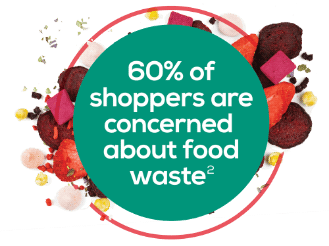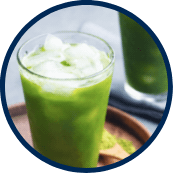Growing up, many of us avoided eating fruit with a brown spot or tossed out the rinds. As adults, how often do we bypass that last head of lettuce or refuse to buy something that is still a day or two away from its “Best by” date. On the larger, global scale, the ongoing food waste crisis only snowballs around the belief that if something isn’t of the highest quality, that it is of no quality. Through this, more than 1.3 billion tons (yes, tons) of food is wasted per year1. To halt this crisis, the process of discarding imperfections has shifted to an innovative mindset across the food manufacturing industry for showcasing value in new ways.
As a food manufacturer, you can make a largescale impact on this crisis by appealing to the 60% of shoppers concerned about food waste2 by introducing a creative use for ingredients. To reduce food waste, trend-setting food producers are now adding longer lasting ingredients and reimagining how to use the portions of food that would otherwise be thrown away into products such as freeze-dried fruit mixes and air-fried rind chips.
Let’s explore three innovative ways you can help reduce food waste:

1. Wellness Foods
What’s healthy for us can be healthy for the Earth, too. Wellness foods often have an overlapping target market, with half of consumers who view healthy eating as a top priority, one-third of those also say sustainable eating is a priority as well3. This allows you to offer not just health benefits, but also sustainable, reduced food waste benefits for those looking for a “best of both worlds” product.
Whether it be by adding the leftover pulp from nut-milks to a gluten-free cracker or freeze-dried probiotic fruit purées to a post-workout mix, your health-conscious clientele can feel good about doing their part in choosing reduced waste foods.

2. Snacks
Who doesn’t love to snack?!? Guilt-free snacking can be even better when you offer sustainable benefits to your shopper through your ingredients and sourcing process. In fact, 55% indicate they’re more likely to purchase a packaged food item if it includes a sustainability claim4.
Instead of sticking with standard components, R&D teams can get creative by adding more sustainable, repurposed freeze-dried or baked ingredients, within the formulation. Not only do these ingredients appeal to consumers looking to reduce food waste because of their extended shelf life, they provide the satisfying crunch factor people are looking for.

3. Restaurants
Whether it’s to celebrate a promotion, or experience a new dish, we all love going out to restaurants or cafes. While enjoyable, an enormous amount of food is wasted at restaurants, with reports showing that half a pound of food is wasted per meal5. Actively trying to minimize that waste, 72% of people stated that they would support a foodservice business that’s committed to reducing food waste2.
Your restaurant can appeal to the pro-food waste reduction audience by being intentional with your ingredient selection. Opting to use imperfect ingredients on your menu, such as transforming a cosmetically imperfect butternut squash into creamy soup or sprinkling freeze-dried strawberries over ice cream instead of fresh ones, can help reduce the waste per plate ratio.

One brand making one change leads to a larger, more significant, reduction of waste. As a food producer, you can join the mission to minimize food waste on a commercial and consumer level. By using ingredients that won’t expire fast, like freeze-dried vegetables, or repurposing imperfect ingredients, such as an oddly shaped tomato, you can develop a delicious product that helps chip away at global food waste.
Despite all efforts to minimize waste throughout the production process—some level of waste is inevitable. To reduce this further, many food manufacturers donate any unused food and beverages to charitable organizations, including local food banks, community shelters, and school programs. If your business has leftover food or beverage products that can still be safely consumed, consider donating to an organization in your area that provides free meals to those in need. Click here for more information on how to locate a local food donation center to help give back while ensuring the most value possible comes from all food produced.
At Chaucer Foods, reducing waste isn’t just a trend for us. As a leading global ingredient supplier, all of our offerings are sourced sustainably and processed in a way that keeps them delicious for longer – without compromising on quality.
References:
1 “Wasted Food Statistics,” The World Counts. 2023.
2 “Consumers show preference for retailers that reduce waste,” Food & Beverage Insider. 2021.
3“Hungry and confused: The winding road to conscious eating,” McKinsey & Company. 2022.
4“55% of consumers more likely to purchase sustainable food products,” Food & Beverage Insider. 2022.
5“The Startling Reality of Food Waste In Restaurants,” Move for Hunger. 2022.